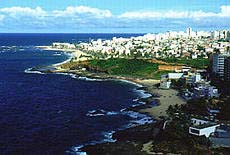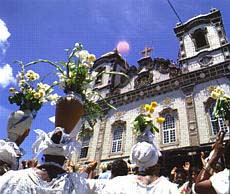Advertising by Google
Salvador, Bahia
Area: 313 km²
Population: 2.443.107 in Salvador, nearly 3.300.000 in the metropolitan area. Salvador is the third most populated city in Brazil, after São Paulo and Rio de Janeiro.
See map of Bahia.
See also weather in Salvador.
The name Salvador means "Savior". The full name of the city is São Salvador da Bahia de Todos os Santos, or "Saint Savior of the Bay of All Saints"; Bahia de Todos os Santos was the name given by Portuguese explorers in 1501, when they arrived at this natural anchorage, with blue water guarded from wings and flow. The name Bahia (= Bay) would become the name of the State).
 Much more than just the capital of Bahia, Salvador, Brazil, is synonymous with a state of mind. It is the Brazilian city which most evokes relaxation, spontaneity, feasts and religiousness. African culture and ethnical heritage are more significant in Salvador than in other capitals on Brazil, and involves the city in an atmosphere of joy and enchantment. Baianos are proud to be black in their music and dancing, in their rituals and parties, in their dressings, in their food, beliefs and religiosity.
Much more than just the capital of Bahia, Salvador, Brazil, is synonymous with a state of mind. It is the Brazilian city which most evokes relaxation, spontaneity, feasts and religiousness. African culture and ethnical heritage are more significant in Salvador than in other capitals on Brazil, and involves the city in an atmosphere of joy and enchantment. Baianos are proud to be black in their music and dancing, in their rituals and parties, in their dressings, in their food, beliefs and religiosity.
Salvador is the main port of entry of foreign tourist to North-East Brazil. Tourists are immediately captivated by its charm, by its infrastructure of hotels and the combination of city and architecture, which finds its greatest expression at the Pelourinho (pelourinho is the name of the wooden mast where slaves were punished; there used to be hundreds of pelourinhos across the country, but only a few remain; another touristic pelourinho is found in the city of Alcantara, state of Maranhão).
The Pelô, as the pelourinho of Salvador is affectionately called by the Bahians, is located in the Historical Center of Salvador; this area was declared World Heritage site by Unesco, and is the greatest collection of colonial architecture in Latin America.

Sons of Gandhi
Its pavements, steep streets and public squares serve as permanent stages for musical presentations, and are the strongholds of Olodum, Ilê-Ayê and the Sons of Ghandhi (see photo), Afro groups (percussion bands based on African rhythms) which draw crowds the whole year round, particularly during the Carnival.
Founded in 1549 on a hill overlooking the bay of All Saints, Salvador was the first capital of Brazil. In 1763, when gold had taken the place of sugarcane as main produce of Brazil, it lost this status to Rio de Janeiro. It still retains its splendour from the golden years in which it enjoyed the status of seat of government of the Colony, in the form of the Basílica Cathedral, an example of Portuguese architecture, where in 1697 father Antônio Vieira passed away.
Seat of the first Catholic diocese in the country, Salvador retains from that period and previous decades buildings which are considered true architectural relics. Of particular prominence amongst these are the church and convent of Saint Francis, one of the richest religious establishments in Brazil. The baroque façade of the church, dated 1723, conceals treasures inside, such as Portuguese panels which show the legend of the birth of Saint Francis and his renunciation of worldly goods. Read more info (in Portuguese) about the churches of Salvador.
 Next to these buildings can be found the church of the Third Order of Saint Francis, dated 1702, and a convent. The set back facade of the temple alludes to the Spanish baroque. There are beautiful paintings on the roof, painted by Franco Velasco in 1831. In the convent, tiled panels created in 1729 portray the nuptials of the firstborn son of Dom João V, the infant Dom José, with the Lisbon of before the 1755 earthquake in the background.
Next to these buildings can be found the church of the Third Order of Saint Francis, dated 1702, and a convent. The set back facade of the temple alludes to the Spanish baroque. There are beautiful paintings on the roof, painted by Franco Velasco in 1831. In the convent, tiled panels created in 1729 portray the nuptials of the firstborn son of Dom João V, the infant Dom José, with the Lisbon of before the 1755 earthquake in the background.
However, the most popular church in Bahia is that of the Senhor do Bonfim, where every year during the second fortnight of January, Bahians in traditional costume wash its steps. Built on a hill, it was decorated with white Portuguese tiles in 1772, a century after it was finished. Its façade is rococo and the interior neoclassic.
There are also museums in Salvador, such as the Sacred Art Museum and the Modern Art Museum.
Other landmarks of Salvador are the Elevador Lacerda (four cabins which serve tens of thousands a day), which connects the Tomé de Souza square in the Upper City to the Cairu square in the Lower City, separated by a drop of 72 metres; and the Model Market, with more than 300 stalls where one can buy arts and crafts products of Bahia, next to restaurants and bars with typical food and drink.
Read more:
Salvador. Comprehensive Travel guide in Portuguese.
Universidade Federal da Bahia. The Federal University of Bahia, campus in Salvador.
Salvador in German. Info about Salvador, in German language.
Salvador official site. Maintained by the city government.
Pictures of Salvador En français. Très bon.
En français. Très bon.
Back to Top